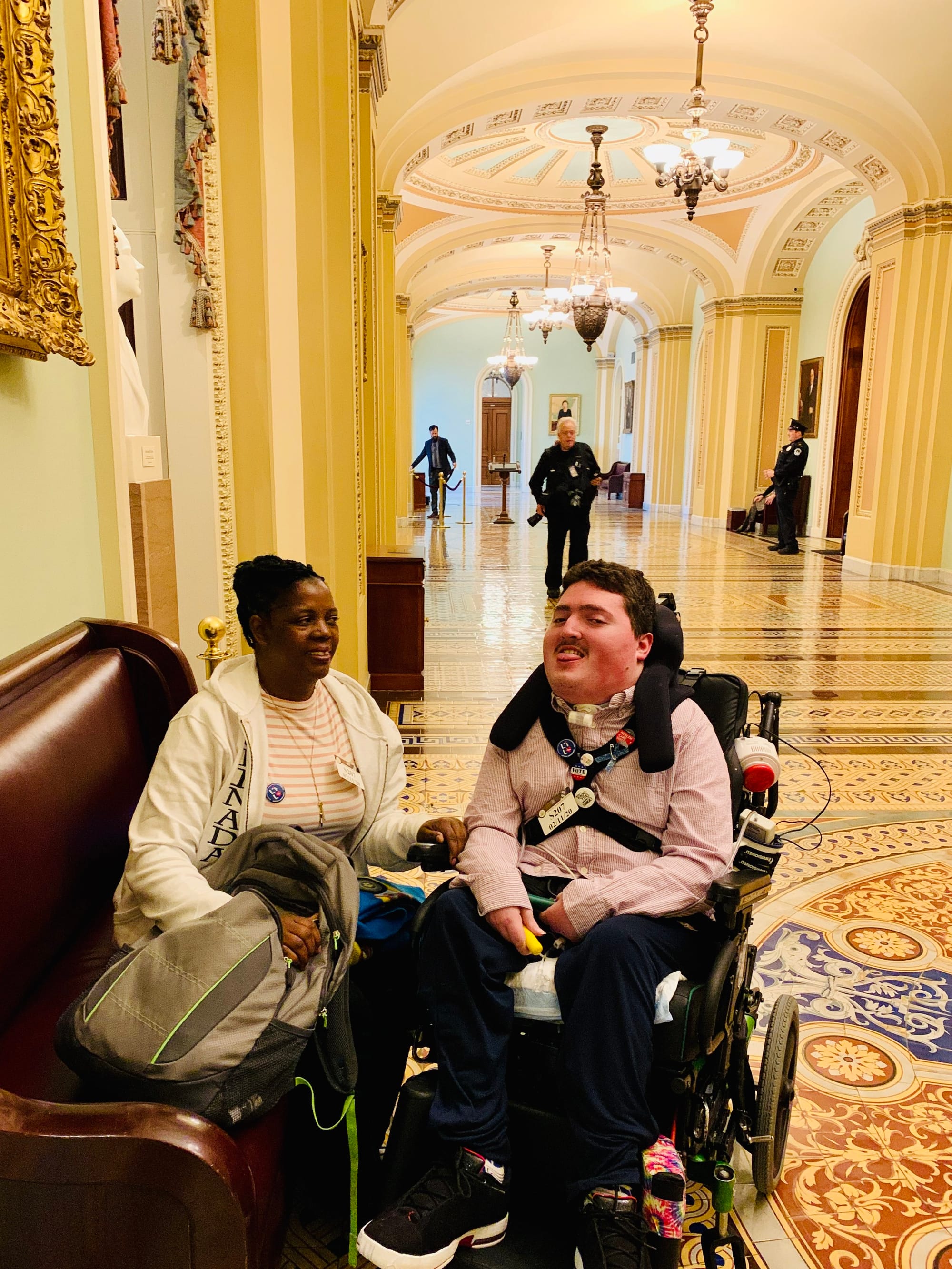Living the Life You Want: Self-Directed Services 101 (by Jeneva Stone)

Rob Stone (r) with his nurse Justine (l) in the U.S. Capitol Building after a press conference on health care. [image description: A young man with light skin is seated in his wheelchair. His wheelchair vest is decorated with advocacy pins. A woman with dark skin and black hair in a bun sits on a bench next to him. They are in a hallway of the U.S. Capitol building, the floor covered with decorative tiles in yellow, brown and blue. Decorative columns, chandeliers, and archways are in the background.]
What happens to disabled young adults after high school? Many families don’t know what to expect when school ends.
The Individuals with Disabilities Education Act (IDEA) makes education an entitlement for students with disabilities, ensuring them a place in their communities. However, families quickly learn as high school draws to a close that community living for adults with disabilities is not (yet) an entitlement or a guarantee. This critical period of decision making is known as “transition to adulthood,” or just “transition.”
While some disabled students go on to college or get a job, others, particularly students with developmental disabilities, transition from high school to state Home and Community-Based Services (HCBS) programs funded through Medicaid. Most states offer HCBS waivers through one of two models: one, “traditional providers,” (nonprofits or government agencies), or, two, “self-directed services.” In some states, self-directed services are known as “consumer-directed services.”
Traditional providers each offer their own custom blend of activities. Disabled youth must apply to each provider they’re interested in, and providers are free to reject any applicant, often without providing a reason. Many traditional providers will not consider applicants with complex medical needs, regardless of whether the applicant’s interests match those of the provider.
Self-directed services has its roots in a belief generations of disability rights activists have shared: That disabled people have the basic human right to self-determination. Parent activists bucking society and raising their children at home also became part of what is known as the Independent Living movement of the 1970s, which began dismantling institutions and demanding community inclusion and self-determination for disabled people. Ed Roberts has become the most visible activist of this movement; however, his efforts built on those of many others. The Robert Wood Johnson Foundation was a pioneer in self-directed services as the first organization to provide grants for doing so. Self-direction is based on a belief that anyone can, with the right level of support, manage their own life.
According to the national organization Applied Self-Direction, all 50 states have at least one HCBS waiver that can be self-directed, for a total of 260 programs and 1.2 million individuals served nationwide. In a traditional services model, activities and opportunities are determined by the agency, and the agency hires staff. In self-direction, the disabled individual sets up a Person-Centered Plan, which allows them to choose their own activities, plan their own days, decide where they’d like to live, and choose their own staff.
SDAN’s video, “Self-Direction and the Good Life,” explains the core values of self-direction and the lives several of its members live. [image description: A young man with light skin and short brown hair smiles broadly. He is in a grocery store.]
When my son Rob transitioned, his complex medical needs excluded him from being considered by most traditional providers in Maryland, where we live. Furthermore, Rob had decided he wanted to be a writer, an artist, and an advocate, and no traditional providers offered him a chance to pursue all of those goals. Rob was thrilled to plan his own life through self-direction.
Rob has become an enthusiastic member of Maryland’s Self-Directed Advocacy Network (SDAN), which believes that self-advocates and the families who love them—not bureaucrats and consultants—know, themselves, how to create their best lives. Flexibility and choice are SDAN’s guiding principles as it strives to protect its members, and SDAN’s legislative champions in Maryland’s General Assembly have recently introduced legislation in the House and Senate to protect the interests of self-directed participants like Rob.
From 2011 to 2019, self-directed participation increased over 16%, according to an AARP report. During the pandemic, those numbers have only risen. Because of this enthusiasm, many states are struggling to “rebalance” their Long-term Supports and Services (LTSS), of which HCBS waivers are one part.
States must consult often with the Centers for Medicare and Medicaid Services (CMS), review their waiver language, and, sometimes, revise regulations and budgets. Because institutions and nursing homes haven’t gone away, and traditional providers are often struggling to make their own programs more flexible and community-based, there are lots of voices clamoring to be heard in state government deliberations.
To ensure that our school-aged children have good options for living their best lives as adults, people with disabilities and their families must join those voices clamoring to be heard! There is life after high school, and we all must advocate and fight for the tools and programs that will turn dreams into realities.
As our blog explores transition issues and opportunities, we will, going forward, present information on as many options as possible.
Jeneva Stone is the Little Lobbyists blog manager. She is also a writer. If you’d like to write a blog post for Little Lobbyists contact Jeneva!
